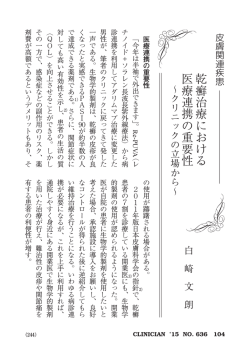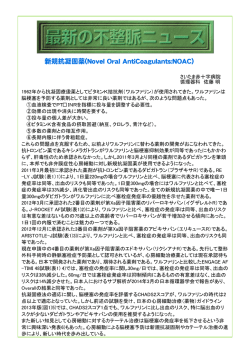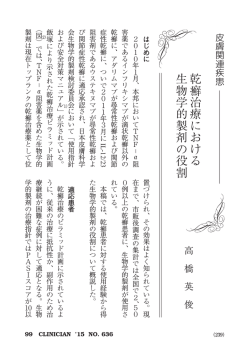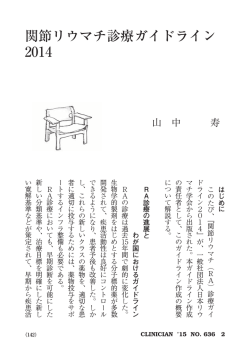
PCI 後の心房細動患者に 対する抗血栓療法
掃 本 誠 治 小 川 久 雄 * トピックス PCI後の心房細動患者に 対する抗血栓療法 た、初回心筋梗塞患者4万812例を対象とし 冠動脈ステント留置後、ベアメタルステント ︵BMS︶にせよ、薬剤溶出性ステント︵DE ピドグレル単剤群4・6%、ビタミンK拮抗薬 年間発生率はアスピリン単剤群2・6%、クロ はじめに S︶にせよ、アスピリンとチエノピリジン系の 単剤群4・3%、3剤併用群 ・0%で、アス た登録研究において、抗血栓薬併用時の出血の 抗血小板薬2剤併用療法が一般的であるが、心 房細動合併、あるいは人工弁術後であれば抗凝 ピリン単剤群を対照とした出血の Hazard Ratio ︵HR︶は、3剤併用群で4・ ︵ %CI 3・ 95 心房細動と虚血性心疾患の合併と出血リスク ∼5・ ︶と、最も高リスクであった︵図①︶ 。 1) 固薬も必要となる。高齢化により心房細動は増 加しており、3剤の抗血栓薬︵2剤併用抗血小 板療法︵DAPT︶+抗凝固薬︶が一定期間必 12 05 抗血栓薬の併用療法では、単剤よりも2剤、 心房細動は、男女とも年齢とともに有病率が 2剤よりも3剤で出血のリスクが上昇する。ま 上昇し、高齢化に伴い年々増加することが予測 要となる。 33 78 CLINICIAN Ê15 NO. 637 (346) 08 ① (文献1より) ②心房細動有病率の推移と予測 %、本邦では6∼ 頻度は、海外では約 に合併する心房細動 心筋梗塞、それぞれ ンション︶施行症例、 的冠動脈インターベ また、PCI︵経皮 さ れ て い る︵ 図 ② ︶ 。 2) 8%程度と報告され 10 により増加する。 6) 7) スクは明らかに併用 +抗凝固薬の出血リ DAPTとDAPT 板薬単剤+抗凝固薬、 小板薬単剤と抗血小 ている。また、抗血 3) 4) 5) (347) CLINICIAN Ê15 NO. 637 79 (文献2より作成) ③ 䕔myocardial infarction/coronary death Treatment regimen 䕔bleeding Treatment regimen HR 䠷95% CI䠹 HR 䠷95% CI䠹 1.76 [1.05-2.94] VKA + Aspirin + Clopidogrel 2.81 [1.82-4.33] VKA + Clopidogrel 1.53 [0.93-2.52] VKA + Clopidogrel 1.84 [1.11-3.06] VKA + Aspirin 1.12 [0.94-1.34] VKA + Aspirin VKA 1.00 (reference) VKA 1.00 (reference) Aspirin + Clopidogrel 2.24 [1.76-2.84] Aspirin + Clopidogrel 1.04 [0.76-1.42] Clopidogrel 1.73 [1.27-2.34] Clopidogrel 1.12 [0.75-1.65] 1.73 [1.48-2.02] Aspirin VKA + Aspirin + Clopidogrel Aspirin 0.5 1.0 1.50 [1.23-1.82] 0.72 [0.59-0.87] 0.5 1.5 2.0 2.5 3.0 1.0 1.5 2.0 2.5 3.0 Hazard Ratio Hazard Ratio 䠄Horizontal bars indicate 95% confidence interval䠅 䠄Horizontal bars indicate 95% confidence interval䠅 䕔all-cause death 䕔thromboembolism Treatment regimen HR 䠷95% CI䠹 VKA + Aspirin + Clopidogrel VKA + Clopidogrel Treatment regimen HR 䠷95% CI䠹 1.31 [0.66-2.59] VKA + Aspirin + Clopidogrel 1.85 [1.29-2.65] 1.39 [0.94-2.06] 1.56 [0.84-2.90] VKA + Clopidogrel VKA + Aspirin 0.86 [0.67-1.09] VKA + Aspirin VKA 1.00 (reference) VKA 1.00 (reference) Aspirin + Clopidogrel 1.77 [1.32-2.38] Aspirin + Clopidogrel 1.81 [1.52-2.16] 1.73 [1.18-2.53] Clopidogrel 1.34 [1.13-1.70] Aspirin Clopidogrel Aspirin 0.5 1.0 0.99 [0.86-1.13] 1.61 [1.28-2.01] 1.49 [1.32-1.67] 1.5 2.0 2.5 3.0 0.5 Hazard Ratio 1.0 1.5 2.0 2.5 3.0 Hazard Ratio 䠄Horizontal bars indicate 95% confidence interval䠅 䠄Horizontal bars indicate 95% confidence interval䠅 50 CLINICIAN Ê15 NO. 637 ワルファリンのエビデンス vs ァリンは 年以上日常臨床で使用されている薬 剤で、急性心筋梗塞後のワルファリン プラセ 8) ボの大規模臨床研究でワルファリンの有効性が vs 示されている。さらに心筋梗塞後、アスピリン ワルファリン アスピリン+ワルファリンの 3群での比較研究では、アスピリン+ワルファ 9) リン併用群、ワルファリン群、アスピリン群の 順に心血管イベント抑制効果が優れていた。し かしこの試験でのPT INR︵プロトロンビ ン時間国際標準比︶は2・8∼4・2と現在の 実臨床より高値で設定されており、出血合併症 が多かったこともあり推奨されなかった。安定 冠動脈疾患を合併した心房細動患者のデンマー クでのコホート研究では、ワルファリンに抗血 (348) 小板薬を追加しても心血管イベントリスクは減 少せずに出血リスクが増加した︵図③︶ 。 10) − vs 冠動脈疾患には低用量アスピリンを終生投与 するのが現在のガイドラインであるが、ワルフ 安定冠動脈疾患合併の心房細動患者の VKA に抗血小板薬を追加してもイベントリスクは減 少せず、出血リスクが増加した。 Forest plots show adjusted hazard ratios with error bars indicating 95% confidence interval (CI). (文献10より) HR:hazard ratio、VKA:vitamin K antagonist(ビタミン K 拮抗薬) 80 ④ CHADS2スコア ⑤ CHA2DS2-VASc スコア (文献11より) PCI後の心房細動患者に対する抗凝 固薬の脳梗塞予防効果を検討した 登録研究では、全体では CREDO-Kyoto 抗凝固薬の有無で脳梗塞リスクに違いは なかったが、ワルファリンの効果の指標で あ るT T R︵ Time in Therapeutic Range ︶ が良好な患者より不良な患者において心 血管イベントリスクが上昇することが報 脳卒中リスク、出血リスク 心房細動患者における 告されている。適切な使用が望まれる。 2 心房細動患者における脳卒中発症リス クの評価指標として、 CHADS スコアや、 ス コ ア が あ り、 合 併 疾 CHA2DS2-VASc 患の有無により点数化している︵表④⑤︶ 。 また、抗凝固療法を行う心房細動患者 における、出血イベントの発現リスクを 11) 12) (349) CLINICIAN Ê15 NO. 637 5) 評価する方法として、HAS BLED − 81 (文献12より) ⑥ HAS-BLED スコア (文献13より) > 歳、抗血小板 65 が、2014年に発表 joint consensus document された︵図⑦︶ 。 欧州心臓病学会から、急性冠症候群合併ある いはPCI施行の心房細動患者での抗血栓薬の ステント留置時のガイドライン 心房細動患者における いほどリスクが上昇する。 リスク、3点以上は高リスクであり、点数が高 評価する。0点は低リスク、1∼2点は中等度 があれば各1点として点数化し、出血リスクを 薬やNSAIDsの使用、アルコール依存など NRコントロール不良、年齢 肝機能異常、脳卒中、出血または出血傾向、I スコアがある︵表⑥︶ 。高血圧、腎機能異常、 13) ⑴脳卒中リスク スコア CHA2D2-VASc ⑵出血リスク HAS BLEDスコア ⑶病態 安定冠動脈疾患か急性冠症候群か ⑷抗血栓療法 どの抗血栓薬をどのくらい使用 − 82 CLINICIAN Ê15 NO. 637 (350) 14) ⑦ CAD:冠動脈疾患、ACS:急性冠症候群 (文献14 より) (351) CLINICIAN Ê15 NO. 637 83 するか ピドグレル+アスピリン289例︶で、安全性 と有効性を比較した試験である。平均年齢 歳、 男性 %、抗凝固薬投与の理由として、心房細 薬に減量し、 カ月以上では、左冠動脈主幹部 て層別化し、可能なら抗血小板薬単剤+抗凝固 ・2%、機械弁はそれぞれ ・2%と ・7% 動が2剤併用群で ・5%、3剤併用群では 基本的には、出血リスクの高い3剤併用︵D APT+抗凝固薬︶の期間を前記の条件に従っ 70 3剤併用群が有意に高値だった︵3剤 ・4% だった。結果として、1年間の出血イベントは、 10 69 病変などを除き可能なら抗凝固薬単剤への切り 10 69 80 替えが推奨されている。 12 除いて、抗凝固薬+抗血小板薬単剤が合理的で AHA/ACC/HRSの心房細動ガイドラ イン2014でも、PCI後 CHA D -VASc ス 2 2 コアが2点以上では、慢性期にはアスピリンを 血行再建術 3剤併用群 ・6% 2剤併用群 死亡+心筋梗塞+ステント血栓症+標的血管再 ドポイント 一次エンドポイント+脳卒中+全 2剤 ・4%/図⑧a ︶ 。また心血管イベン 44 あると記載されている。 19 vs 留置されて抗凝固薬を服用する患者において、 これらは、WOEST試験の結果を反映して いる。WOEST試験は、心房細動や機械弁を 可能ではないことを示した意義は大きい。 するというこれまでの発想とは異なる処方が不 リンを止めて抗血小板薬単剤と抗凝固薬2剤に 患者で、ステント留置術を受けたとき、アスピ +抗凝固薬の3剤併用群︵ワルファリン+クロ ン︶+クロピドグレル284例︶と、DAPT 冠動脈ステント挿入後、クロピドグレルと抗凝 ・1%/図⑧b︶ 。抗凝固薬を服用している 17 トは、2剤併用群が有意に低かった︵複合エン vs 固薬の2剤併用群︵経口抗凝固薬︵ワルファリ 15) 11 84 CLINICIAN Ê15 NO. 637 (352) 16) 最後に NOAC︶を含めて現在進行中の研究結果次 第では変更されていくだろう。いろいろな抗血 小板薬と抗凝固薬の組み合わせが可能となり、 b.副次評価項目:(全死亡、脳卒中、心筋梗塞、 ステント血栓症、標的血管再血行再建術) (文献16より) 検定法:ログランク検定 (353) CLINICIAN Ê15 NO. 637 85 冠動脈疾患合併心房細動患者における抗血栓 療法については、ワルファリン以外の経口抗凝 検定法:ログランク検定 固薬︵ Non Vitamin K antagonist oral anticoagulant また、合併疾患を有したリスクの高い症例に対 ⑧ WOEST 試験 a.主要評価項目:全出血イベント(TIMI 基準) するカテーテルインターベンションが増えてく ると思われるが、出血・血栓塞栓症のリスクと ベネフィットのバランスを考えることが重要と なってくる。 ︵熊本大学大学院生命科学研究部 循環器内科学 教授、 国立循環器病研究センター 副院長︶ 循環器内科学 准教授︶ ︵*熊本大学大学院生命科学研究部 文献 Sorensen R, et al : Risk of bleeding in patients with acute myocardial infarction treated with different combinations of aspirin, clopidogrel, and vitamin K antagonists in Denmark : a retrospective analysis of nationwide registry data. Lancet, 374, 1967-1974 (2009) Ohsawa M, et al : Rapid increase in estimated number of persons with atrial fibrillation in Japan : an analysis from national surveys on cardiovascular diseases in 1980, 1990 and 2000. J Epidemiol, 15, 194-196 (2005) Kirchhof P, et al : Management of atrial fibrillation in seven European countries after the publication of the 2010 ESC Guidelines on atrial fibrillation : primary results of the PREvention oF thromboemolic events European Registry in Atrial Fibrillation (PREFER in AF). Europace, 16, 6-14 (2014) Akao M, et al : Current status of clinical background of patients with atrial fibrillation in a community-based survey : the Fushimi AF Registry. J Cardiol, 61, 260266 (2013) − Goto K, et al : Anticoagulant and antiplatelet therapy in p a t i e n t s w i t h a t r i a l f i b r i l l a t i o n u n d e rg o i n g percutaneous coronary intervention. Am J Cardiol, 114, 70-78 (2014) Toyoda K, et al : Dual antithrombotic therapy increases severe bleeding events in patients with stroke and cardiovascular disease : a prospective, multicenter, observational study. Stroke, 39, 1740-1745 (2008) Uchida Y, et al : Impact of anticoagulant therapy with dual antiplatelet therapy on prognosis after treatment with drug-eluting coronary stents. J Cardiol, 55, 362369 (2010) Smith P, et al : The effect of warfarin on mortality and reinfarction after myocardial infarction. N Engl J Med, 86 CLINICIAN Ê15 NO. 637 (354) 4) 5) 6) 7) 8) 1) 2) 3) 323, 147-152 (1990) Hurlen M, et al : Warfarin, aspirin, or both after myocardial infarction. N Engl J Med, 347, 969-974 (2002) Lamberts M, et al : Antiplatelet therapy for stable coronary artery disease in atrial fibrillation patients taking an oral anticoagulant : a nationwide cohort study. Circulation, 129, 1577-1585 (2014) Gage BF, et al : Validation of clinical classification schemes for predicting stroke. Results from the national registry of atrial fibrillation. JAMA, 285, 2864-2870 (2001) Camm AJ, et al : Guidelines for the management of atrial fibrillation : the Task Force for the Management of Atrial Fibrillation of the European Society of Cardiology (ESC). Eur Heart J, 31, 2369-2429 (2010) Pisters R, et al : A novel user-friendly score (HASBLED) to assess 1-year risk of major bleeding in patients with atrial fibrillation : the Euro Heart Survey. Chest, 138, 1093-1100 (2010) Lip GY, et al : Management of antithrombotic therapy in atrial fibrillation patients presenting with acute coronary syndrome and/or undergoing percutaneous coronary or valve interventions : a joint consensus document of the European Society of Cardiology Working Group on Thrombosis, European Heart Rhythm Association (EHRA), European Association of Percutaneous Cardiovascular Interventions (EAPCI) and European Association of Acute Cardiac Care (ACCA) endorsed by the Heart Rhythm Society (HRS) and Asia-Pacific Heart Rhythm Society (APHRS). Eur Heart J, 35, 3155-3179 (2014) January CT, et al : 2014 AHA/ACC/HRS guideline for the management of patients with atrial fibrillation : executive summary : a report of the American College of Cardiology/American Heart Association Task Force on practice guidelines and the Heart Rhythm Society. Circulation, 130, 2071-2104 (2014) Dewilde WJ, et al : Use of clopidogrel with or without aspirin in patients taking oral anticoagulant therapy and undergoing percutaneous coronary intervention : an open-label, randomised, controlled trial. Lancet, 381, 1107-1115 (2013) (355) CLINICIAN Ê15 NO. 637 87 15) 16) 9) 10) 11) 12) 13) 14)
© Copyright 2024

![[Vol.A06] ULTRON ES-OVM](http://s1.jadocz.com/store/data/000766897_1-feec4f95a14aba78373a255046b59b30-250x500.png)


